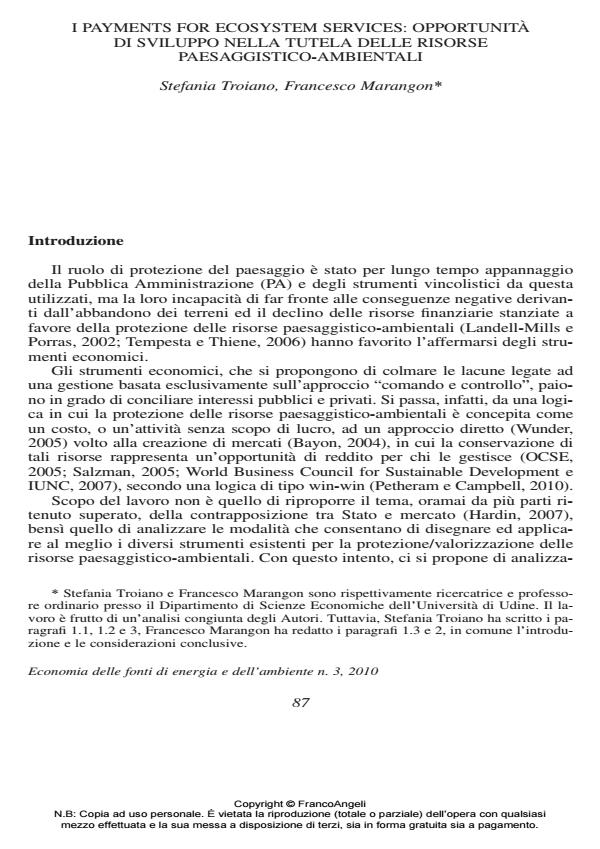Payments for Ecosystem Services: Development opportunities from landscape and environmental resources management
Journal title ECONOMICS AND POLICY OF ENERGY AND THE ENVIRONMENT
Author/s Stefania Troiano, Francesco Marangon
Publishing Year 2011 Issue 2010/3
Language Italian Pages 27 P. 87-113 File size 827 KB
DOI 10.3280/EFE2010-003006
DOI is like a bar code for intellectual property: to have more infomation
click here
Below, you can see the article first page
If you want to buy this article in PDF format, you can do it, following the instructions to buy download credits

FrancoAngeli is member of Publishers International Linking Association, Inc (PILA), a not-for-profit association which run the CrossRef service enabling links to and from online scholarly content.
Landscape provides a wide range of benefits to people. There is increasing consensus about the importance of conserving these "ecosystem services". Despite their high practical value ecosystem services provided by landscape - with rare exception - are neither prized by markets nor explicitly protected by the law. In detail, the command and control instruments usually used by government to protect landscape have been demonstrating not to be able to counteract landscape abandonment. Consequently there is increasing pressure to use innovative instruments for promoting, but also financing landscape conservation. Economic theory suggests that some form of contracting between the beneficiaries and the providers could result in an optimal supply of ecosystem services. In recent years, a number of initiatives around the world have sought to create markets for ecosystem services provided by landscape. National governments and public- private partnerships involving local communities, NGOs, firms and municipalities are among the many actors driving these initiatives. Some markets are dependent on government intervention, while some other are created by entirely private ventures. Payment for ecosystem services (PES) is a recent instruments innovation attracting attention in both developed and developing countries. It involves voluntary payments for ecosystem services that are conditional on service delivery. They compensate individuals or communities for undertaking actions that increase the provision of ecosystem services. PES schemes rely on payments to induce behavioral change, thus they can be considered part of the group of incentive- or market-based instruments for environmental policy. The analysis of PES is considered one of the most important themes in sustainable environmental research. There is therefore a need to identify and address its pitfalls. The piece reviews the literature on PES and identifies some key requirements for instrument design. In fact, although simple in appearance, the definition of PES hides many technical complexities. We argue the opportunity to use this instruments in Italy to conserve landscape. We try to offer a set of lessons about how the context of a PES instruments is likely to interact to produce effectiveness in achieving conservation goals and sustaining landscape health more generally. We continue by discussing some questions about preconditions necessary to develop PES and by pointing out that quantifying the levels and values of ecosystem services provided by landscape is considered so useful and persuasive but has proven difficult. We point out that establishing PES is a very complex undertaking. In fact, it requires the consideration of scientific but also economic, social, political, institutional, etc. relationships to avoid that possible adverse effects can occur in particular where property rights are insecure. Moreover, we note that PES may need to be complemented with other approaches to address landscape conservation. The conclusion provides some policy recommendations for the future development of PES initiatives in favour of landscape in Italy, assuming that they should be favoured over the more traditional regulatory and tax-based approaches in far more settings than commonly assumed.
Keywords: Payment for Ecosystem Services, landscape and environmental resources, sustainable development
Jel codes: H4, H23, Q57
- It's a jungle out there - the strange animals of economic organization in agri-food value chains F. Marangon, S. Troiano, pp.357 (ISBN:9789086868445)
Stefania Troiano, Francesco Marangon, I Payments for Ecosystem Services: opportunità di sviluppo nella tutela delle risorse paesaggistico-ambientali in "ECONOMICS AND POLICY OF ENERGY AND THE ENVIRONMENT" 3/2010, pp 87-113, DOI: 10.3280/EFE2010-003006